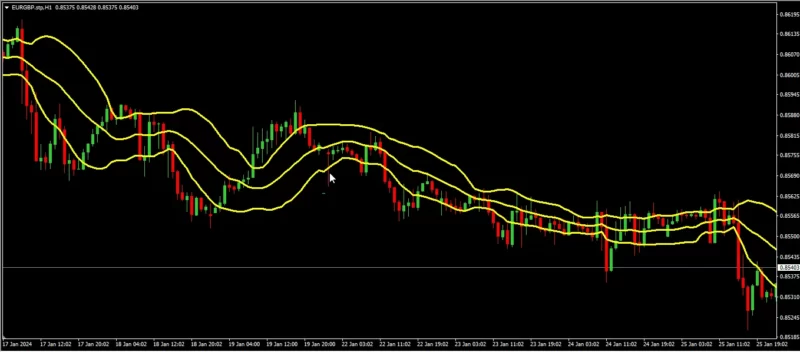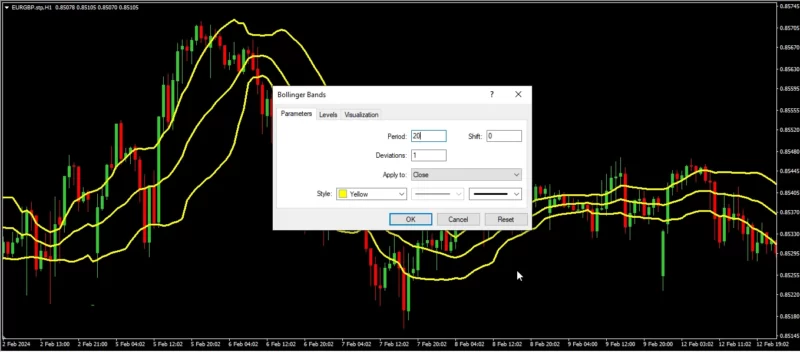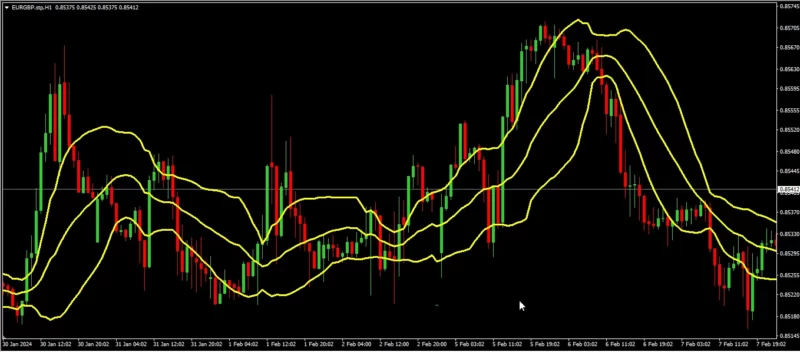Bollinger Bands, a creation of John Bollinger within the Nineteen Eighties, is an adaptable technical evaluation instrument relevant to varied monetary devices equivalent to indices, currencies, and shares. As indicators of overbought or oversold circumstances and a measure of volatility, Bollinger Bands play an important function in market evaluation.
What are Bollinger Bands?
Bollinger Bands encompass three strains on a buying and selling chart. The center line is the 20-day Easy Shifting Common (SMA), surrounded by an higher band (SMA + 2 commonplace deviations) and a decrease band (SMA – 2 commonplace deviations). These bands act as an envelope across the instrument’s value, with widths decided by the usual deviation, representing value volatility.
Bollinger Band Calculation System:
The calculation includes a 20-day SMA and a couple of commonplace deviations. The higher band is calculated as (20-day SMA + 2 * 20-day commonplace deviation), and the decrease band as (20-day SMA – 2 * 20-day commonplace deviation).
Find out how to Use Bollinger Bands:
Merchants use Bollinger Bands on completely different timeframes to identify overbought or oversold circumstances. When the worth will get near the higher band, it signifies overbought, suggesting an opportunity to promote. On the flip facet, if it heads to the decrease band, it hints at oversold circumstances, suggesting a possible shopping for alternative.
Complementary Instruments: Shifting Averages, Stochastic Indicator, ATR, and Keltner Channels:
Whereas Bollinger Bands are highly effective, combining them with different indicators enhances precision. Shifting averages, Stochastic indicators, Common True Vary (ATR), and Keltner Channels are beneficial additions. Our new platform simply combines instruments, serving to merchants make sensible choices.
Bollinger Bands Technique:

Merchants use Bollinger Bands in numerous methods. One technique is “driving the bands,” however be cautious and don’t mistake band penetrations for indicators. One other technique, the “Bollinger Band squeeze,” predicts larger volatility when the bandwidth hits a six-month low. When utilizing these methods, it’s vital to know when to purchase and promote. Think about shopping for when costs contact the decrease band, indicating a possible shopping for alternative. Then again, take into consideration promoting when costs contact the higher band, suggesting a attainable reversal. Understanding these methods and their indicators helps merchants navigate the markets extra precisely.
Greatest Bollinger Bands Settings:

Tailoring Bollinger Bands to completely different timeframes and buying and selling methods is crucial. Lengthy-term merchants could desire month-to-month charts, whereas day merchants go for shorter timeframes. There’s no common timeframe; it is determined by the dealer’s technique.
Bollinger Band Patterns:

Merchants acquire insights by recognizing patterns like double bottoms and reversals. Double bottoms present a change from sellers to consumers, typically resulting in upward actions. Reversal patterns, breaking higher or decrease bands, could point out development modifications.
Bollinger Band Buying and selling System:
Our user-friendly on-line buying and selling indicator web site has varied evaluation indicators, like Bollinger Bands. Merchants simply use indicators, draw trendlines, and discover purchase/promote factors. 4xPip tutorials assist customers maximize their expertise.
Find out how to Interpret Bollinger Bands:
Bollinger Bands work however have limits. They react to costs, not predict them, resulting in attainable false indicators. To beat this, merchants alter settings primarily based on their methods. Many mix Bollinger Bands with different indicators for a complete strategy.
Conclusion:
To grasp Bollinger Bands, perceive how they work, use them with different instruments, and customise them in your technique. Uncover their energy on our Subsequent Technology indicators for a greater buying and selling expertise with 4xPip. Discover the positioning’s EAs, together with Bollinger Bands, and start your buying and selling journey now. For assist, contact 4xPip’s skilled assist at [email protected].
FAQ’s
What are Bollinger Bands and the way do they work in market evaluation?
Bollinger Bands point out overbought or oversold circumstances and measure volatility in monetary devices.
How do Bollinger Bands assist merchants establish overbought or oversold circumstances?
When costs strategy the higher band, it indicators overbought, prompting potential promoting alternatives.
Can Bollinger Bands be used on completely different timeframes, and the way are they adjusted?
Sure, Bollinger Bands are versatile, adaptable to varied timeframes, and will be adjusted for various buying and selling kinds.
What’s the significance of mixing Bollinger Bands with different technical indicators?
Combining with instruments like shifting averages and stochastic indicators enhances precision in market evaluation.
What methods do merchants use with Bollinger Bands for bear or bull markets?
Common methods embrace “driving the bands” and the “Bollinger Band squeeze” for figuring out potential market actions.
How do merchants set the perfect Bollinger Bands settings for his or her buying and selling methods?
Setting Bollinger Bands is determined by the dealer’s technique, with no common timeframe appropriate for all.
What Bollinger Band patterns ought to merchants acknowledge for actionable insights?
Figuring out patterns like double bottoms and reversals supplies merchants with beneficial and actionable insights.
What function does the Bollinger Band buying and selling system play on the Subsequent Technology platform?
The Subsequent Technology platform integrates Bollinger Bands seamlessly, permitting merchants to make knowledgeable choices with technical evaluation.
What are the restrictions of Bollinger Bands, and the way can merchants mitigate dangers?
Bollinger Bands are reactive however liable to false indicators. Merchants typically use them along with different indicators for a holistic strategy.




